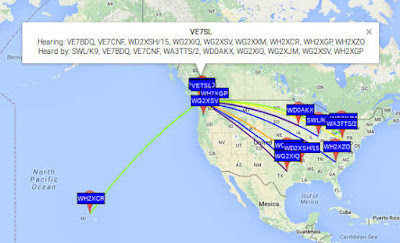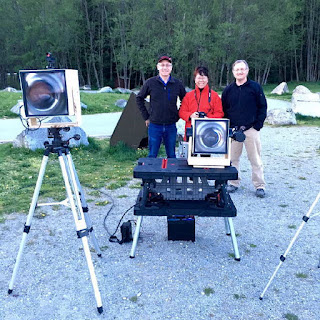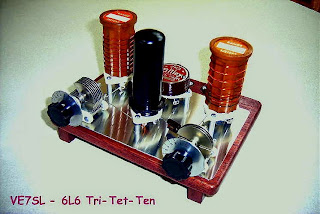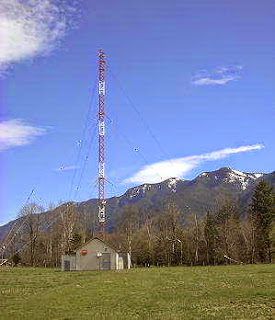Posts Tagged ‘CW’
 A Tip o’ the Hat
A Tip o’ the Hat
I really have to extend a hearty "tip o' the hat" to all you QRP SSB guys out there. Not being used to SSB operations, not being used to QRP SSB operations has provided me with a learning experience. In your writer's most humble opinion, QRP SSB has a difficulty factor of 10X compared to QRP CW.
Today during lunch time, I was hunting around for NPOTA stations on 20 Meters. Not hearing anything on the CW bands, I moved on up to the realm of voice - foreign territory, indeed!. There I heard two stations. K0USA on 14.260 MHz and K0RP on 14.340 MHz. K0RP was very weak, with QSB making it worse. K0USA was a good 5X5 into NJ and even 5X7 when QSB would let up. I decided to concentrate on Mary, who was the op behind the mic. It took the better of 15 minutes, but I got in the log - and it was a new one for me, MN46, the Homestead National Historical Monument in Nebraska.
For her part, Mary did a superb job dealing with my weak signal. Only 5 Watts to the Buddistick has gotten me decent results on SSB in the past, but today, with the monstrous QSB, it was their beam (which was pointed south, by the way - I was off the side) and her great ears that made the difference. I owe her a ton of gratitude for sticking with me and granting me the ATNO.
Getting back to the topic of SSB vs CW ..... I'm pretty confident in my CW skills. From past practise, it's pretty easy for me to gauge who is workable and who isn't. I still get surprised from time to time; but I've gotten pretty good at figuring out who I am able work and who I am not..
QRP SSB is still a crap shoot for me. Like I stated, it's foreign territory. To make things even worse, shall we say that patience is a "hard won virtue" for me? Living in New Jersey all my life, I'm used to the fast pace of the Northeast. Things, especially at work, are wanted yesterday. I'm used to dealing with that, and delivering those kind of fast results. The downside is, that I've come to expect that, in return. Waiting is still a battle for me. Not in all situations, but in many - especially when I am dealing with myself.
QRP SSB is an extra hard challenge for me and will be for quite a while. The upside is hopefully, I'll become more skilled at it; and I'll also gain more patience, because of it..
72 de Larry W2LJ
QRP - When you care to send the very least!
 CW Forever …?
CW Forever …?
 |
| 24 Hour 'JT' 6m Activity |
The transverter develops just over 70 watts output when run on 13V and so far, has been able to take all of the nightly punishment I've been able to throw at it with flying colors. Here is a WSPRnet screen shot taken from a typical night of my WSPR beaconing on 630m:
 |
| courtesy: KB5NJD's 630m Info |
I was also able to have my first JT-9 mode QSO this week, with Toby, VE7CNF. This mode is the weak-signal WSPR QSO mode, tailored for LF/MF work and allows for calls, signal reports and confirmations (R's) to be exchanged ... the minimum requirements needed to claim a contact. Although additional information can be exchanged, its 13-letter message buffer does not exactly promote ragchew style conversations and some creativity is required to exchange more than the basics.
With many of our newer 'digital-savy' amateurs not necessarily being proficient in CW, I suspect that JT-9 may well evolve to become the go-to weak signal communication mode on 630m, much as it has in Europe. In fact, popularity of this mode in Europe has already spawned a few JT-9 contest weekends on 630m, with high activity levels being reported. I'm really looking forward to a 630m JT-9 QSO party in North America, once the band becomes a reality in the U.S.A.
JT-9 is capable of decoding signals reliably down to -24db SNR and boasts a 50% reliability of decoding at -26db SNR. Audible CW drops out at around -16 to -18db SNR, so communicating with JT-9 is the equivalent of going from 100 watts to around 800 watts ... a significant improvement and very helpful on 630m! Like WSPR, JT-9 will work with non-linear transverters and amplifiers such as the commonly-used and simple to build switching MOSFET Class D/E styles.
There also appears to be a fast-growing use of JT-65A on the 6m band this summer, with numerous 'CW forever' operators finding the mode's ability to dig up to 10db deeper into the noise paying off with surprising results. Some western North American operators have noticed that European JT-65A signal levels indicate that they should be in the CW-copiable range yet no CW activity is heard, for which there seems to be no ready explanation. Perhaps more will be learned this summer as the use of this mode continues to expand.
As one of the 'CW forever' proponents willing to try something different, I also have been listening for and working stations on 6m over the past few days on JT-65A. With the IC-756ProIII throttled back to 25 watts, I've found it fairly easy to make contacts when the band is open but have yet to hear or work anything unusual.
I'd love to hear your own comments on the use of JT-9 or JT-65A, particularly on 630m or on 6m ... maybe you can pass along some tips for those of us that are new to the mode on this band.
I may have to reconsider this 'CW forever' thing!
 Bureau QSL Batch
Bureau QSL Batch

The batch of bureau cards last week included several cards from Europe and were probably the last I'll get for my Cycle 24 10m fun, using the homebrew Tri-Tet-Ten.
As mentioned previously, this rig was the culmination of wondering, for many many years, if I could get a single 6L6 to work well enough on 10m CW, using a 40m crystal ... quadrupling to 10m ... and still have enough useful output to work Europe! As well, the note would have to be 'acceptable' as I realized that any crystal chirping would be multiplied four times, during the quadrupling process.
The evolution of my eventual transmitter, is described in more detail here, where you can also hear what the tone sounds like. Suffice to say, the results were much more than I had ever hoped for and during the peak years of this past cycle, many enjoyable hours were spent on 10m CW with my one tube tri-tet crystal oscillator.
I guess I could always move down to 20m CW but, for me, this just doesn't have the same appeal or sense of satisfaction as using it on 10m or what I like to call, "the other magic band". Who knows what Cycle 25 will bring to 10m? I may get another chance yet, if the solar prognosticators are all wrong!
 Music To My Ears
Music To My Ears
 In my 'other' life, before retiring, I taught high school for 35 years. I soon became tired of doing my nightly lesson preps and marking of papers on the kitchen table so I built a large oak roll-top style desk, but without the 'roll' part.
In my 'other' life, before retiring, I taught high school for 35 years. I soon became tired of doing my nightly lesson preps and marking of papers on the kitchen table so I built a large oak roll-top style desk, but without the 'roll' part.It had lots of drawers, both big and small, slots and cubby-holes, and made the nightly homework very much more enjoyable.
The left end of the desk was occupied by my Sony ICF -2010 and above it, on the desk's top shelf, was a small amplified and tuneable ferrite loop antenna. The Sony was tuned to the 500kHz international MF 'distress' frequency, which was mainly used as a CW calling frequency for ships wishing to work the coastal traffic handling stations. Once contact was established, stations would move to the 'QSS' working frequency used by the coastal, so that the distress frequency was not tied-up.
As I sat at the desk doing my nightly prep, the silence would be broken every few minutes with the sound of a CW caller, either a coastal or a ship. It was music to my ears.
On a normal night, the numerous coastals could be heard with their periodic traffic lists interspersed with ships up and down the coast calling with traffic or weather reports. However, on a really good winter night, the frequency was almost constantly abuzz with CW. Ships, as well as the coastals, could be heard from the Gulf of Alaska down to the Gulf of Mexico ... as far west as the Hawaiin Islands and on really rare nights, along the eastern U.S. seaboard. On those nights, 500kHz would sound like 20m CW, even on my little Sony and desktop loop.
Thanks to the forethought of those that had the good sense to record some of those amazing sounds, you can step back in time and listen to what '500' sounded like back in its prime ... recorded somewhere in western Europe.
The most recent 630m crossband activity brought back these pleasant memories of what the band could sound like at times, with several very strong VE7's and a few weaker U.S. experimental stations to the south, all busily calling CQ at the same time on various frequencies. I consider it a huge privilege to be able to operate on this much revered part of the radio spectrum ... one steeped in such great CW tradition.
I think it won't be too long before 630m will sound much like its old glory days again ... and wouldn't that be a wonderful thing.
 A Second West Coast Lightwave Adventure
A Second West Coast Lightwave Adventure
 |
| 51km Path courtesy: https://www.google.ca/maps |
Toby, VE7CNF, successfully inaugurated his lightwave station earlier this week, on Monday night, completing a nice two-way CW contact between West Vancouver (CN89) and Mayne Island (CN88). The distance spanned was approximately 51km (32 miles), crossing atop the western edges of Vancouver and then across the Strait of Georgia, the body of water separating mainland BC from Vancouver Island.
The details of Toby's homebrew lightwave equipment are described on his web site here and are similar to the station at this end ... also described in earlier blogs. This was the same path covered in my two previous lightwave QSO's with Markus, VE7CA, described here.
Monday evening's weather was clear and calm but at this time of the year, true darkness is a long time coming. With a full-moon just a few nights away, the sky never did get very dark it seemed. I set up my end of the path late in the afternoon, just in front of the house.
VE7CNF/7 end showing the busy-looking site in operation.
Accompanying Toby to the mountain lookout location were VA7MM, his YL VA7MAY and Markus, VE7CA who initially scouted out and found this nice site for our original lightwave contacts. Thanks to Markus who snapped a picture of the diehard lightwave crew!
 |
| VA7MM, VA7MAY and VE7CNF |
Although Toby's signal was very strong, the lighting hum was strong enough to cause some receiver front-end desensing and slightly modulate Toby's CW signal with a touch of AC ripple. I did not notice this hum when working VE7CA at the same location a couple of years ago. It's possible that there was no snow on the ski-hill at the time and the lights were not turned on.
Moving the receiver just a few degrees to the west made a huge difference, as the hummy background noise level returned to the quiet hush of a dark sky.
Toby's recording of my signal is much cleaner as there are no bright lights when looking towards Mayne Island. It is really interesting to hear the rapid fading, almost a flutter, on my CW signal, as the light passes through various levels of ever-changing haze above the water.
Midway through our one hour QSO, Toby reported that my signal had dropped measurably as had his signal on my end. Although I could see no obvious clouds in the path, I did notice a red glow out in the Strait that had not been there earlier. When I turned off my transmitter, the glow disappeared, indicating that there was indeed some low level haze that had crept up on us, and enough to cause some signal absorption on the path. Thankfully signal levels returned to normal, and actually were a bit stronger, about fifteen minutes later, when the haze thinned and the skies had grown a little darker.
Towards the end of our QSO, I had the chance to test out my #2 receiver. It was built so that I could do some NLOS cloudbounce testing here on the island, without having to separate my main system's transmitter/receiver pairing. At the time, there were no lenses available from the overseas manufacturer, so my quest for a suitable lens led me to a local 'bargain style' hardware importer (Princess Auto), who had a good supply of $5 lenses. The lens seemed to function well in my local tests but it had never been put side-by-side with the higher quality lens in my main transceiver. As it turned out, the $5 lens worked very well, easily detecting the 51km signal although it didn't sound quite as loud since the receiver I built for it was intended to interface with my laptop and lacked the additional audio amp I had built for the main system.
A final interesting observation was made, when on a whim, I placed a large cardboard shield over the bottom quarter of the transceiver's receiver lens. The signal strength didn't appear to change at all. I gradually blocked more and more of the lens but astonishingly, was still able to copy Toby's CW with all but a 1" strip of the lens completely covered! This would tend to indicate that we would be able to communicate with a very much smaller Fresnel or optical glass lens, such as a 4" or even a 2" inch magnifier. As I commented to Toby on CW, the possibilities for experimentation are endless.
All-in-all it was a very successful evening and the mountain-top gang seemed to enjoy the outing as much as I did, and ... the QSL is in the mail.
Hopefully there are other VE7's in or around Vancouver that might be interested in throwing a signal over this way some night ... I'll leave the light on for ya!
 Hunting For NDB’s In CLE 206
Hunting For NDB’s In CLE 206
This coming weekend will see another CLE challenge, this time in the LF band from 190 - 239.9 kHz.
'CLE's' are 'Co-ordinated Listening Events', and NDB DXers around the world focus their listening time on one small slice of the NDB spectrum.
One nice catch to try for is 'LU' on 214 kHz shown on the left. The 'LU' NDB is in a breathtaking location, high on a mountain meadow at the foot of the North Cascade mountain range. In spite of the towering mountain peaks to the east and to the south, 'LU' is well heard, being reported as far east as Massachusetts and as far west as Hawaii.
The antenna is a 100' top-loaded vertical with, presumably, an extensive ground system as this is a very large site. The transmitter is a 500 watt Nautel. 'LU' is about 20 miles north-east of the Abbotsford Int'l Airport, Vancouver's alternate.
From CLE coordinator Brian Keyte (G3SIA), comes the following reminder:
Our 206th Co-ordinated Listening Event is next weekend.
Do join in if you can. First-time CLE logs will also be very welcome.
Days: Fri. 22 - Mon. 25 April, Midday-Midday, your local time
Frequencies: NDBs from 190 - 239.9 kHz
PLUS: Normal NDBs on 'half-way' frequencies nnn.5 kHz
(from 190.5 - 999.5 kHz)
Both halves are for everyone to try.
Away from Europe many of the frequencies below 240 kHz are busy with
NDBs. In Europe there are very few there, but some DX ones might be heard from North America and maybe from a few other places.
The normal NDBs (not DGPS) which have carriers on the 'half-way'
frequencies (e.g. 284.5 DY, 333.5 VOG, 370.5 LB, 390.5 ITR, 433.5 HEN)
are scattered across Europe but there are very few of them elsewhere.
'Hot spots' are ENG and ITA.
These half-frequencies give comfortable QRM-free listening and probably
some good catches as a result.
America has only one or two (e.g. 381.5 SJX) but East and West coasters
might hear some DX ones.
We last used these 'rules' for CLE190 in January 2015.
Please send your CLE log to the List in a plain text email if possible
(not in an attachment) with 'CLE206' at the start of its title.
Show on each log line:
# The date (e.g. 2016-04-22, etc., or just 22) and UTC.
(the date changes at 00:00 UTC)
# kHz (the nominal published frequency, if known)
# The Call Ident.
Show those main items FIRST - other optional details such as Location
and Distance go LATER in the same line.
If you send interim logs, please also send a 'Final' (complete) log.
As always, tell us your own location and brief details of the equipment
that you were using during the weekend.
Good listening - enjoy the CLE
----------------------------------------------------------
From: Brian Keyte G3SIA ndbcle'at'gmail.com
Location: Surrey, SE England (CLE co-ordinator)
----------------------------------------------------------
(If you wish you could use any one remote receiver for your loggings,
stating the location and owner - with their permission if required.
A remote listener may NOT also use another receiver, local or remote,
to make further loggings for the same CLE).
73
Brian
These listening events serve several purposes. They:
- determine, worldwide, which beacons are actually in service and on-the-air so the online database can be kept up-to-date
- determine, worldwide, which beacons are out-of-service or have gone silent since the last CLE covering this range
- will indicate the state of propagation conditions at the various participant locations
- will give you an indication of how well your LF/MF receiving system is working
- give participants a fun yet challenging activity to keep their listening skills honed
Final details can be found at the NDB List website, and worldwide results, for every participant, will be posted there a few days after the event. If you are a member of the ndblist Group, results will also be e-mailed and posted there.
The very active Yahoo ndblist Group is a great place to learn more about the 'Art of NDB DXing' or to meet other listeners in your region. There is a lot of good information available there and new members are always very welcome.
If you are contemplating getting started on 630m, listening for NDBs is an excellent way to test out your receive capabilities as there are several NDBs located near this part of the spectrum.
You need not be an ndblist member to participate in the CLEs and all reports, no matter how small, are of much value to the organizers. 'First-time' logs are always VERY welcome!
Reports may be sent to the ndblist or e-mailed to either myself or CLE co- ordinator, Brian Keyte (G3SIA), whose address appears above.
Please ... give the CLE a try ... then let us know what NDB's can be heard from your location! Your report can then be added to the worldwide database to help keep it up-to-date.
 North American QRP CW Club
North American QRP CW Club
Later this year, the North American QRP CW Club will celebrate its twelfth year of existence. Birthed during a prolific period when many small ham radio groups coalesced into online radio clubs, the NAQCC has become one of the most successful of the litter.
There’s good reason why this club has continued to thrive where others have faded — you simply won’t find a more active or enthusiastic group of wireless telegraphers on the planet.
The timing was impeccable as interest in QRP activity was peaking in the amateur radio world around the time of the club’s formation. But you would be wrong to assume that the rapid rise of the NAQCC was merely a “fad” as sustained growth in the intervening years have proven.
John Shannon, K3WWP co-founded the organization (along with Tom Mitchell, WY3H) and was its guiding light over the first decade.
Shannon’s resume as a QRP CW operator is polished and he easily straddles the two centuries of our hobby – old school ham radio on the one hand, embracing the Internet as an effective means for spreading his minimalist view of amateur radio on the other.
The many activities of the NAQCC keep members as busy as they want to be on the air. That’s by design. While the NAQCC maintains a wealth of online resources to help new operators in the metamorphosis from beginner to seasoned operator, there’s an understanding among members that they should be on the air, not online — and to that end, the club doesn’t maintain a discussion-type mailing list.
On-air activities include regional nets, sprints, and challenges – like collecting letters from worked call signs to spell keywords. Special operating events are frequent and interesting, many of them taking place outdoors.
On a local level, there are seven chapters around the United States and overseas. These provide opportunity for fellowship, sometimes over coffee, breakfast or sharing a hamfest table.
This seems vital to the success of the organization given that it was created and exists in a virtual world. There’s no club headquarters, office, or paid staff. Its global presence and outreach exists by radio, the Internet, postal mail, and through local chapters.
When asked about those club activities he most enjoys, John Smithson, N8ZYA, Vice-President of the organization, said his favorite activity is the monthly challenges. He likes puzzles and the challenges are “much like doing the crosswords in the morning newspaper” – except it takes place via radio.
A particularly effective tool employed by the club is its monthly newsletter the NAQCC News. It appears as a PDF the first of each and every month. Trust me, this isn’t one of those clubs that publishes a “monthly” newsletter a few times each year as is common in our hobby.
Composed, edited, and published by club President Paul Huff, N8XMS, the publication shows up month after month, chocked full of club news, information, and member articles. It’s well-written and a joy to consume at a leisurely pace. The latest edition (April 2016) tips the scales at 49 pages – it’s more like a magazine than a newsletter.
Co-founders K3WWP and WY3H have since retired and moved on from their leadership roles. By all appearances, that transition has been smooth and seamless, a credit to the founders. There are plenty of reasons why such a change might threaten the continuation of any organization, but this has not been the case for the NAQCC.
Grounded on strong fundamentals and an abundance of enthusiasm, the future looks bright for this specialty club, and the legacy of John Shannon, K3WWP seems firmly cemented in this chapter of amateur radio history.
With over 8,000 members in all 50 states, 9 VE provinces, and 101 countries, the NAQCC might be be for you – if you’re seeking fun, new adventure, friendship, or something to rekindle the magic of radio.
Take a look at this video montage for a complete overview of the club and its activities.
Membership is free, and I’ve no doubt you will be welcomed with open arms.
![]()






















